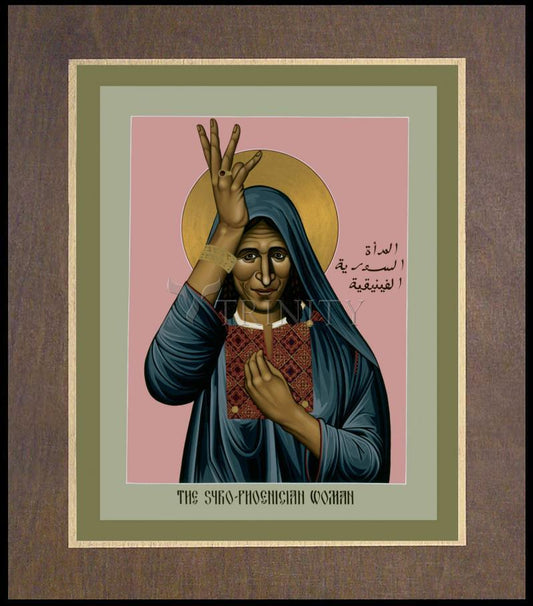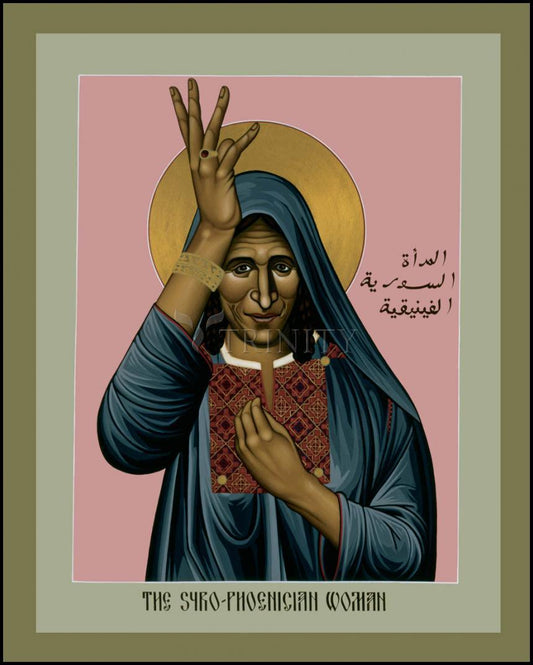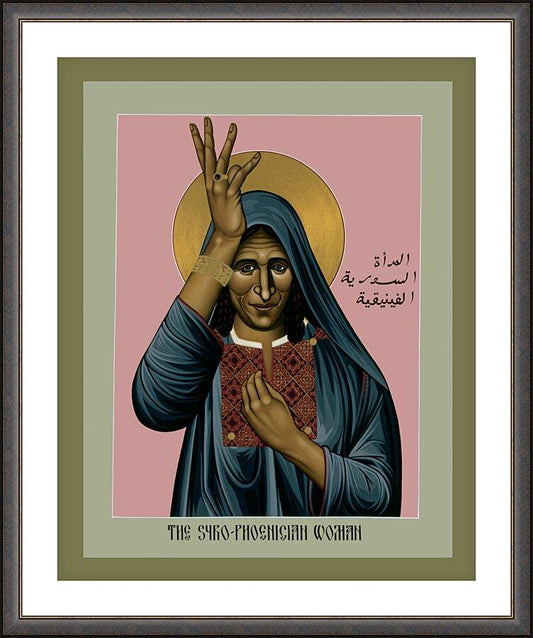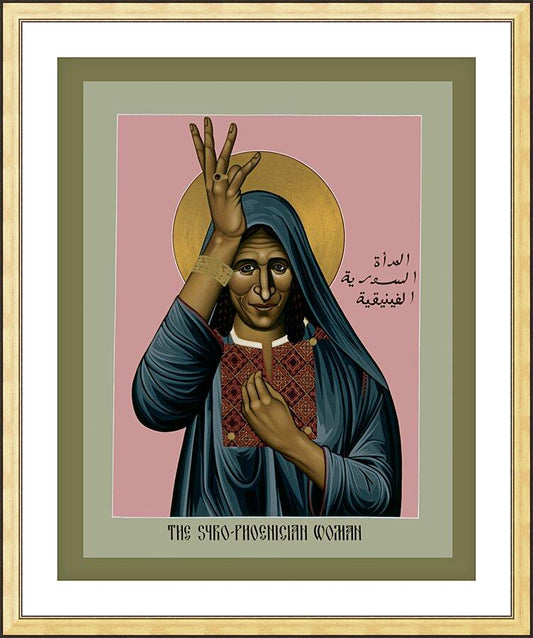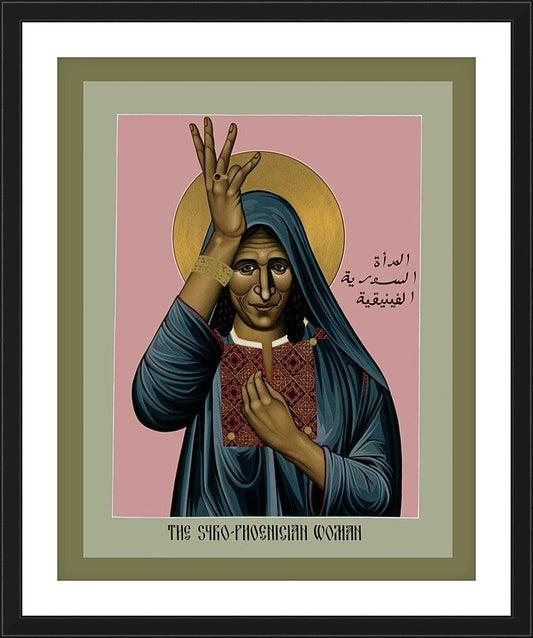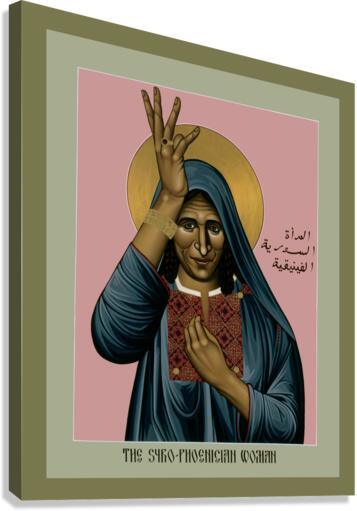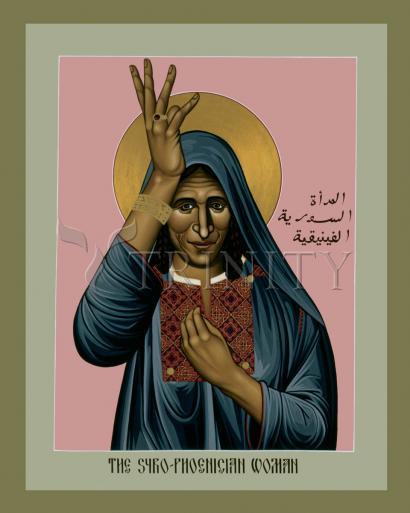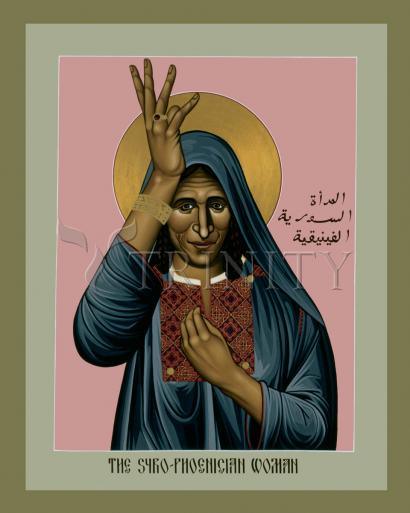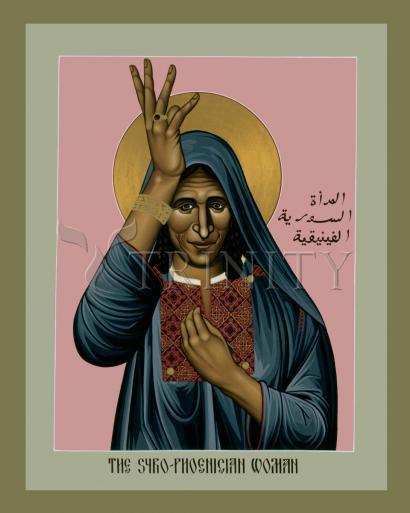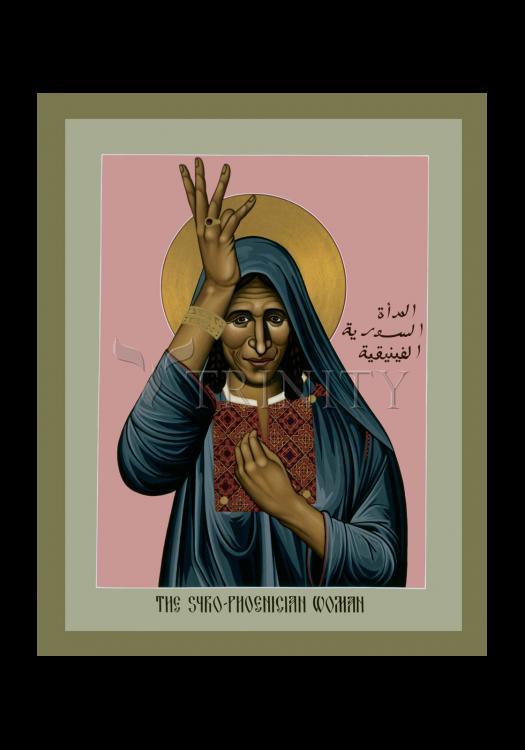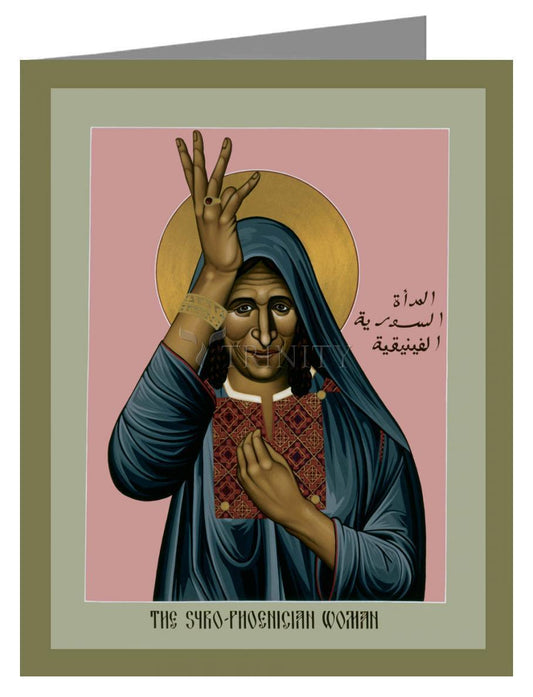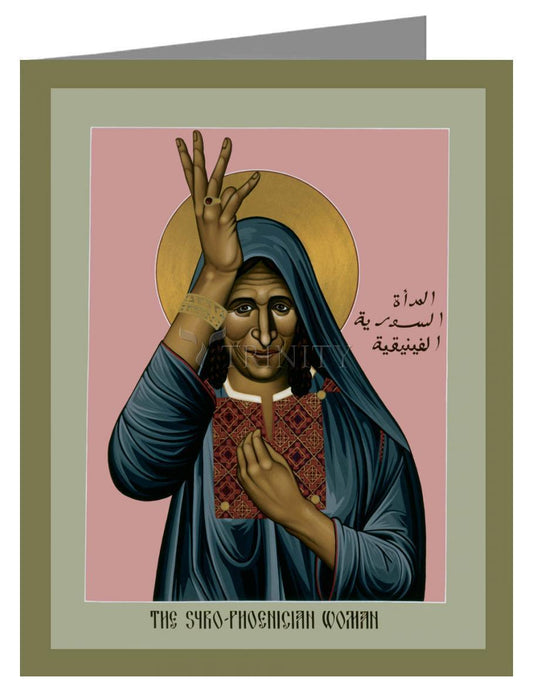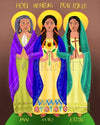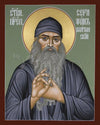The Syrophoenician woman periscope (a selection from a book) is found in Mark 7:25-30 and paralleled in Matthew 15:21-28. Mark's version of the story reads:
A woman whose daughter had an unclean spirit heard about Jesus, and came and fell down at his feet. The woman was a Greek, by race a Phoenician from Syria. And she started asking him to drive the demon out of her daughter. He responded to her like this:
"Let the children first be fed, since it isn't good to take bread out of children's mouths and throw it to the dogs! (kynaria)" But as a rejoinder she says to him: "Sir, even the dogs under the table get to eat scraps dropped by children!" Then he said to her: "For that retort, be on your way, the demon has come out of your daughter." She returned home and found the child lying on the bed and the demon gone (Mk. 7:25-30).
In agreement with all but a few commentators, my discussion assumes the priority of Mark and the two-source hypothesis (which is to say that Mark's gospel was written first and later redacted by Matthew and Luke). We should also keep in mind that the Syrophoenician woman pericope floated around in the oral tradition long before Mark wrote his gospel and continued to thrive well into the second century. Matthew certainly knew Mark's version of the story, but he may also have known of the same (or a modified) version of the story in the oral tradition.
Matthew probably took over Mark's version as the basis for his own redaction, modifying it for his own community's theological needs. Perhaps a different version of the story from the oral tradition influenced Matthew as well. I shall first outline the story in its context within Mark's gospel and then discuss Matthew's parallel passage. An analysis of the story will follow.
Hermeneutic
Bultmann calls the story of the Syrophoenician woman an apothegm (a witty saying) which has the purpose of recounting a miracle of Jesus -- specifically an exorcism --performed during the Galilean phase of his ministry. A secondary element of the story is to dramatize the conflict concerning the place of Gentiles within the early Jesus movement. Since Mark's gospel is informed by the oral tradition, he preserves what Philip Sellew identifies as the three-part formula of description, performance, and demonstration.
This formula is useful in an oral tradition because it helps the storyteller remember how to consistently tell and retell a story to an audience. The oral tradition's three-part structure in this story is as follows:
1. Description of the ailment: the woman's daughter is possessed by an unclean spirit.
2. Performance of the exorcism: The demon is exorcised by word alone and mentioned by Jesus in the past tense after the woman's clever repartee.
3. Demonstration of success: we are told that the woman goes home to find that the demon has left her daughter.
The pericope does not preserve details telling us how it was determined that the exorcism was indeed successful. A natural literal reading of the text assumes one of two things. Either the exorcism was verified at a later time and we are just not told of it or, at the time of the exorcism, it was taken for granted on Jesus' authority that the healing did occur. However, a literalist reading is neither appropriate nor necessary.
The purpose of the story is to proclaim the healing abilities of Jesus and to explain the Jewish-Christian attitude toward the Gentiles. No believer at Corinth or Rome would find it necessary to question the validity of the exorcism's cure; Mark's readers are already convinced of Jesus' skills as a miracle worker. For Mark's audience, the matter is quite simple: a Jewish rabbi hears the pleas of a Greek woman, effects a cure, and the cure is successful.
This miracle story is contrasted to other miracles in Mark in that it does not portray Jesus as touching the daughter to cure her. In particular, Jesus performs a distance-healing cure, rather than a healing involving magical incantation. In the healing of the blind man at Bethsaida (8:22-26) Jesus uses magic by combining spit and touch to effect the cure; and we learn that the blind man's affliction is so serious that Jesus must redouble his efforts and channel power to the blind man a second time before his sight is fully restored. In the case of the deaf mute (7:31-37), Jesus effects the cure by again combining spit -- a common magical healing remedy of the day, considered unclean by Judeans -- with the auditory cry "Ephphatha!" while sticking his fingers into the deaf mute's ears.
Through this magical formula the deaf mute's speech impediment is removed. In still other cases -- such as the healing of Peter's mother-in-law (1:29-31) or the leper (1:40-45) -- merely touching those afflicted persons, so that Jesus' powerful healing energy may pass from he to they, is enough to effect the cure (Mk. 5:30).
The story of the Syrophoenician woman, like the healing of the paralytic (2:1-12) portrays Jesus as a magician who heals others on his own authority (rather than on the authority of established religion) and effects the cure indirectly from a distance. We do not witness the miracle in the present tense as with the deaf mute, but rather learn of it after the cure has been effected.
Mark establishes the theological setting (and conflict to follow) by telling us that Jesus had gone to the Greek region of Tyre. Pokorný argues that Mark's geography is a statement to illustrate "a confrontation of Jesus with the pagan world." The woman hears about Jesus, comes to him, and begs that he drive the demon from her daughter. Mark goes to great lengths to inform us that she was a pagan by telling us that she was both Greek and, by race, a Phoenician.
This foreshadows the confrontation between the pagan world and Jesus' mission to the children of Israel. In response to the woman's request Jesus replies sharply that the children must first be fed while she and her daughter (as dogs) must wait. In retort, the woman cleverly identifies with Jesus' insult and uses it to her advantage by saying that even dogs get a few scraps dropped by children. Jesus recognizes her cleverness and informs her that her daughter has been healed.
The Problem of Harmonization
Glenn Miller presupposes that we can harmonize the Markan parallel into Matthew's version prior to analyzing the story. Miller suggests that "important details are added (to Matthew's version of the story) from the parallel passage in Mark"" and he goes on to conflate a smooth "flow of the text" by mixing and matching elements from both stories into one account. The problem with this approach is that Miller ignores the synoptic problem and the priority of Mark entirely, and he uncritically assumes that both versions are equally authoritative and so can be harmonized prior to analysis.
Mark wrote his gospel about four decades after Jesus (70 CE) and Matthew about one or two decades after Mark (80-90 CE). Both writers received the story of the Syrophoenician woman from someone else, either from the other (in Matthew's case), oral tradition, an elder who may have known someone close to Jesus, or they may have used a combination of all three sources as each saw fit.
Since Mark was written a few decades prior to Matthew, Matthew may have inherited the story entirely from Mark rather than from other sources. If Matthew inherited the story from Mark, as scholarly consensus suggests, then Matthew's additions to Mark's story of the Syrophoenician woman should be explained rather than conflated into the Markan account. Any analysis that assumes that the historical event can be cogently understood by first harmonizing the details of the two subjective stories misses the point of Matthew's redaction of Mark.
Conflating the two accounts can only produce speculative interpretations and ignores Morton Scott Enslin's warning that the synoptics, while literarily dependent upon one another, have their "own very distinct peculiarities which must not be overlooked." If two subjective storytellers happened to be eyewitnesses to an historical event -- as two bystanders who simultaneously witness a car accident are -- then harmonizing their accounts for points of agreement (attestations) may prove fruitful in piecing together what really happened.
However, this analogy fails to hold for Mark and Matthew, because neither evangelist saw the historical event in question. In this case, Mark heard his story from Peter (or another elder), wrote it down, and later Matthew learned of it primarily or entirely from Mark's gospel.
Matthew may have also been aware of different variations of the story still circulating in the oral tradition. It is irresponsible, however, to ignore these pre-canonical transmissions in favor of an apologetic explanation for Jesus' behavior. We can learn a great deal about Mark's and Matthew's theology by considering their stories apart. The changes made by a latter evangelist in light of the first can provide clues for the theological emphases that each stress in their respective gospels.
For example, in Matthew's version the woman refers to Jesus as the "Son of David" but she does not do so in Mark's account. We cannot assume that the woman really did refer to Jesus by his messianic title just because one evangelist says that she does. It may be the case that Matthew's own theology is imposing itself on the story; that is, Matthew himself preferred that the woman address Jesus by his messianic title because this is how Matthew's community understood Jesus. These two versions must first be studied apart in order to see these similarities, differences, and disagreements in the context of each writer's Sitz im Leben that informed their approach to Jesus.
Failing to do so produces uncritical interpretations such as with Miller's argument that the strength of the woman's faith -- mentioned only in Matthew's version -- can retroactively apply to Mark, thus mitigating the harshness of Jesus' encounter with her. In Mark's account, faith is not mentioned at all, rather it is the cleverness of her "retort" that earns her her daughter's exorcism. Faith may or may not have had anything to do with the cure.
Matthew's Parallel
The four important modifications in Matthew's version of the story are:
1. The Greek woman refers to Jesus by the messianic title "son of David" (15:22).
2. At first, Jesus ignores the woman's request and the disciples complain that she is badgering them (15:23).
3. Jesus responds to them by saying that he was sent only to the lost sheep of the house of Israel, i.e., the Jews (15:24).
4. After the clever repartee, Jesus responds by saying that her faith (or trust) is enormous and informs her directly that the exorcism is fulfilled (15:28).
Final Exegesis
It is important to remind ourselves at this point that Mark was not a historian and did not know the chronology of Jesus' life. This may sound obvious to some, but there is a tendency to forget this reality especially when we are projecting our own theology onto the text. Mark's gospel is doxological in that his purpose is to tell us about the hero of his work and Jesus' wondrous deeds.
Mark is not a dispassionate historian who presents Jesus' mission chronologically and without interpretation, but is instead a compiler who strings together individual stories that he has about Jesus into a smooth narrative based upon his own understanding of Jesus' mission. An early source, Bishop Papias (100 CE), spoke with an elder ("the Presbyter") who knew Peter and tells us where Mark received his material. Eusebius quotes Papias' long-lost work in his Ecclesiastical History:
And the Presbyter used to say this, 'Mark became Peter's interpreter and wrote accurately all that he remembered, not, indeed, in order, of the things said or done by the Lord. For he had not heard the Lord, nor had he followed him, but later on, as I said, followed Peter, who used to give teaching as necessity demanded but not making, as it were, an arrangement of the Lord's oracles, so that Mark did nothing wrong in thus writing down single points as he remembered them. For to one thing he gave attention, to leave out nothing of what he had heard and to make no false statements in them.'
Papias' Presbyter argues that it was not possible for Mark to present his gospel in chronological order because he had inherited his stories about Jesus as they were remembered and told by Peter or other elders. By the Presbyter's defensive tone it seems that certain of his contemporaries found Mark's arrangement unacceptable. However, he argues that there is nothing wrong with what Mark did and he insists further that Mark did not alter the individual pericopes of Jesus.
Still, we learn from this that Mark himself decided on their order when placing the individual pericopes within his gospel. Eusebius also gives us a glimpse of what the oral tradition that Mark drew upon looked like. Again citing Papias, Eusebius writes that the oral tradition was easily amended to and interpreted based upon the authority of the teller:
Yet Papias himself, according to the preface of his treatises, makes plain that he had in no way been a hearer and eyewitness of the sacred Apostles, but teaches that he had received the articles of the faith from those who had known them, for he speaks as follows: "And I shall not hesitate to append to the interpretations all that I ever learnt well from the presbyters and remember well, for of their truth I am confident.
For unlike most I did not rejoice in them who say much, but in them who teach the truth, nor in them who recount the commandments of others, but in them who repeated those given to the faith by the Lord and derived from truth itself; but if ever anyone came who had followed the presbyters, I inquired into the words of the presbyters, what Andrew or Peter or Philip or Thomas or James or John or Matthew, or any other of the Lord's disciples, had said, and what Aristion and the presbyter John, the Lord's disciples, were saying. For I did not suppose that information from books would help me so much as the word of a living and surviving voice."
From this account we learn that that the oral body of material about Jesus (which Mark drew upon to compose his own gospel) was a decentralized, thriving activity. Papias came into contact with various elders who, in turn, claimed to be earlier followers of a disciple of Jesus, and their stories were then shared and added to other stories. There was no thought given to historical order, but rather the stories were used for their theological significance and collected alongside other stories in no particular order.
These sayings could be plucked out of the overall repertoire of stories as the teaching situation demanded. This is the material that Mark inherited when composing his own gospel and it was Mark who decided to arrange them into a coherent chronological narrative.
This detail of Mark's composition seems to have been overlooked by Miller (1996) and his source William Lane (1974). Miller assumes that, since the Return of the Twelve (Mk. 6:30-44) and the Healings at Gennesaret (Mk. 6:53-56) precede the Syrophoenician woman pericope in Mark's narrative, then Jesus' encounter with the woman must have occurred after them in time.
William Lane uses this assumption to argue that Jesus and his disciples needed a place to retreat to in order to get away from the Galilean crowds of chapter six. However, given that Mark strung these stories together and decided their order for himself, there is no way short of pure speculation to know whether Jesus was tired, refreshed, or anything of the sort.
The only clue we have in this pericope for Jesus' frame of mind is 7:24 which tells us that "whenever Jesus visited a house he wanted no one to know." This desire for secrecy, however, is a universal reference to Mark's portrayal of Jesus as the "secret Messiah" and cannot be understood as a need to rest in the context of the Galilean crowds. The text tells us that whenever Jesus visited a house he shunned crowds, not that he was tired and desired to rest.
In Dogged Pursuit of Jesus
Much has been written about the role of the Greek woman in the story. Downing makes the interesting observation that the woman's femaleness is stressed by Mark: "She heard of him, a woman did, a woman with a daughter" and she came to him and furthermore she was a Greek woman, a Syrophoenicianess"" In the ancient world it was improper for a woman to directly address a man, but in this story (the only such one in Mark) the woman uncharacteristically initiates the conversation.
In 7:27 Mark uses the diminutive "puppies" (kynaria) in place of the primitive noun "dogs" (kynos). A diminutive is meant to denote something smaller than the noun or verb it serves as the suffix of; for example, in English we say that duckling is the diminutive form of duck. It is Jesus' reproach with the diminutive form of "dog" that raises our eyebrows in this passage, for it seems counter to the popular conception of Jesus that he should use a racial slur against the woman.
Therefore, the best that can be said of this passage is that Jesus' use of the diminutive kynaria only softens the insulting slur, but certainly does not remove it. Nor can we comfort ourselves with warm portrayals of children at home with their puppies. As Camery-Hoggatt correctly observes "this is a rejection of the woman's appeal because she is a Gentile" and as such, she is unclean like a dog.
Mark does not say so explicitly, but Matthew does not hesitate to interpret Mark in this way for he states that Jesus' reason for rejecting the woman was because he "was sent only to the lost sheep of the house of Israel" (Mt. 15:24). We should keep in mind that which Downing points out: "Jesus made no attempt to take his message to Gentile communities (Rom. 15:8; Matt. 10:6; 15:24) and the Syrophoenician woman story provides no exception to this conclusion."
Conclusion
Because this story emphasizes the Jewishness of Jesus, it may provide a glimpse into the actual historical Jesus. In this story Jesus is portrayed within the context of the Jewish understanding of purity since he regards the Gentile woman as unclean. Despite this, we learn that the wisdom teacher was not above appreciating the cleverness of others (even if they are women) since, in Mark, he effected a cure on the basis of the woman's reply.
His mission is to the children of Israel alone, not to the unclean Gentile "dogs" who will not be a part of God's coming rule. However, Mark's readers are encouraged by the story's outcome for it seems possible that Gentiles can participate to some degree in the coming rule of God. Jesus' initial rejection need not be mitigated out of a strange fear that Jesus' image will become tarnished. The moral of the story is bigger than that, for as a result of the woman's brilliant reply participation in God's kingdom is possible for the Gentiles after all.
"”Excerpts from Modern Documents by James Still: The Syrophoenician Woman in Mark 7:25-30/Matthew 15:21-28



